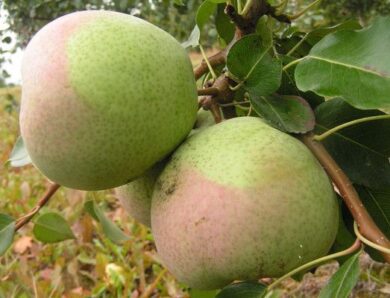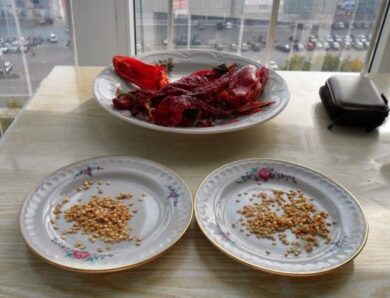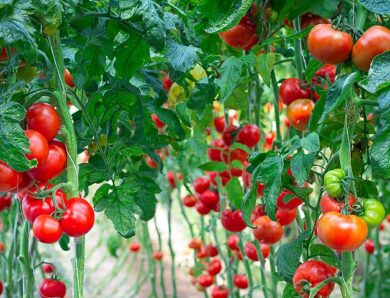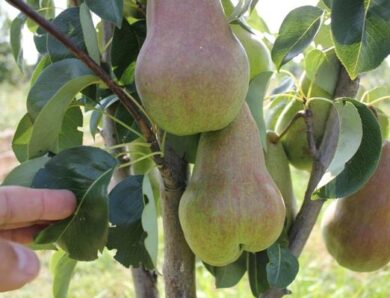Raspberry "Caramel": uniqueness and characteristics of the variety
Remontant raspberry Caramel has long been in demand due to its characteristics and taste. Gardeners like this variety of berries, that it is easy to care for and do not have to look for new ways to increase yields. In this article we will tell our readers in more detail about the variety of raspberry "Caramel", how to choose seedlings for planting, where you want to plant the plant, as well as methods of protection against insects.
Description of the variety and its dignity
Variety of raspberry spray "Caramel" was presented to gardeners back in 2013 year. This sample was in the works more 10 years. Breeders were able to produce an excellent medium-ripe variety, which were satisfied by most farmers and summer residents.
The description of "Caramels" is presented first of all by themes, that the stems of raspberries are medium in size (usually about half a meter). They grow evenly and evenly, which makes the bush erect. Shoots are dense, and you can't make a garter when growing this variety of raspberry.
Unlike most varieties of raspberries, "Caramels" have very small needles on the surface of the stems. This makes it much easier for gardeners to care for the plant, as well as subsequent harvesting. The leaves have a typical shape, as in most other varieties. They are oval and elongate to the edge, with teeth on the tips.
"Caramel" retains a pleasant aroma and sweet rich taste, like its predecessors. Berries have a special pleasure, and also preserve the aroma of wild wild raspberries. The fruits are large, than in varieties, which were used in breeding.
Though, that this variety is still young, in a few years it became very popular. It began to grow in the country, on homesteads, and farmers began to plant this raspberry for a large harvest for sale.
The advantages of raspberries variety "Caramel" include that, that it is well resistant to temperature changes, resistant to frost, if the plant is properly pruned before winter.
As a result of long-term fruiting of this remontant variety gardeners are able to collect a large crop each season.
Usually ripe berries are quite large and can reach a weight of up to 15 grams. It breaks off very easily, the juicy and tender flesh is not damaged. The fruits have a bright red deep color. Thanks to that, that the berry is dense, it is well transported and can retain its appearance and taste for a long time.
As with all varieties of raspberries, Caramels have a number of shortcomings. First of all, it should be noted, that in good conditions the plant will start to grow quickly. The result is a lot of root growth, which the farmer will have to get rid of, if he wants to limit the area for growing berries.
I also want to note, that the plant does not like drought. Therefore, during the cultivation will need regular watering. Otherwise, the plant will wither quickly, and the harvest will be significantly reduced. Particular attention should be paid to moisture in the soil, who undertook to grow "Caramels" in the southern regions.
Variety Review Video
You will learn about it from the video, what kind is it, and what it looks like.
Rules for choosing seedlings
For, so you can get a good harvest at the end of the season, even before planting seedlings need to choose the right seedlings. It is very important to choose healthy seedlings, so that they do not die during the growing season. This is very important for remontant varieties of raspberries, because the fruiting of the plant occurs quite early, and the growth of bushes is very fast.
It is best to buy planting material from certified companies. "Gardens of the Urals" provide quality and healthy seedlings. The advantage of the company "Gardens of the Urals" is that, that your order can be delivered to the specified location, and orders can be placed online. Nursery "Gardens of the Urals" will be a great place for you to buy, if you yourself have not previously chosen seedlings on the market.
If you decide to choose the planting material yourself, then it is advisable to remember some rules of choice.
The first thing to remember, that spring seedlings do not always have leaves. If the planting material has leaves, then this may indicate, that wintering was right. Seedlings look very beautiful, and many novice gardeners are ready to buy it, but this can be a mistake.
Raspberry seedlings are depleted, so much effort went to the leaves. After planting there is a high probability, that flowering in the first year will not be. And such seedlings take root almost twice as badly, than inconspicuous raspberry twigs without shoots.
Then pay attention to that, that the young seedlings should not be withered leaves, which breaks very badly. This fact may indicate that, that the planting material was harvested incorrectly, or it was damaged by insects. As a result, such seedlings simply will not take root in your area.
There should be no signs of disease on last year's shoots, mold. Dark spots or light areas may indicate this, that the seedlings are prone to disease. The cut of the core shoots should be the same color, as well as the subcortical layer of the bush.
Before buying, inspect the rhizome of a young seedling. It must be alive (the roots will bend easily). Best, if the roots are placed in a special nutrient mixture, and packed in a film with a substrate. Seedlings should be smooth. The presence of atypical bends or nodules on the stem may indicate the presence of root cancer.
If you follow these recommendations, then you can significantly increase the chance of success to choose a good seedling. In that case, if this variety of raspberry is not sold in your city, then you can use the services of the company "Gardens of the Urals", placing an order through the site.
How and where to plant
Raspberries varieties "Caramel" is easy to plant. It is enough to follow a number of simple rules.
Remontantny grade "Caramelka" should be planted at the optimum distance from other bushes. Since he has a very developed root system, and root growth will appear during growth, it is best to keep a distance of at least one meter. Experienced gardeners can withstand the distance between rows 120 centimeters, and between the holes with bushes close 80-90 centimeters.
Sunny places should be chosen for planting, where there are no tall trees with thick crowns. Mainly, that the soil was fertile and loose. Priming, where nothing has been grown for a long time, should be well dug and loosened. Only then will it be possible to start planting "Caramels".
It is best to determine the southern part of the site for planting this variety of raspberry. Preferably, so that there are no high barriers nearby, buildings, creating a shadow, and other dense stands.
During the day, raspberry bushes should be illuminated by sunlight, as this will affect the taste and juiciness of the fruit. Shadow areas will significantly reduce yields.
When planting raspberries in the spring it is best to prefer that place, where it snows first. Usually with uniform snow cover, it begins to melt faster on small hills and in areas, which are well fertilized with organic or manure.
It is best to plant raspberry seedlings in early March, when the earth thawed. If you go to plant in the fall, it is better to do it in late September or early October. In autumn, planting material is more preferable, as the conditions for this are favorable. This allows the plant to grow better, will strengthen the cow system until the new season.
Before planting, prepare the soil. A couple of weeks before planting, you should dig the ground well, pull out all the weeds, and make top dressing. Roasted manure is usually used for fertilization, bird droppings, wood ash, peat or nitroammophoska. About three buckets of compost or manure are required per square meter of soil, and 0,2 liters of nitroammophoska.
It is desirable to know before planting, at what depth the groundwater lies. Since "Caramel" does not like excessive moisture in the ground, then the groundwater should be deeper, than one and a half meters.
That seedling quickly began and began to actively grow and develop, you need to follow the rules of planting.
To begin, you need to dig the required number of holes at the appropriate distance, as mentioned earlier. Each hole should be wide, more than half a meter in diameter, and depth on 45-50 centimeters.
Before placing the seedling in the ground should be cut shoots by a third. Then the fertile soil will need to be mixed with compost and a small amount of superphosphate.
You need to make a small height in the hole, and then place the seedling there. Straightening the roots, sprinkle layers of soil and gradually compact it. Importantly, that at landing at rhizomes there were no emptiness. Digging a seedling, it must be well watered. Pour one or one or two buckets of water into the hole, and then sprinkle the ground in the stems with a layer of humus about 5 centimeters.
Care and protection against pests
To get a great harvest, it is necessary to ensure proper care of seedlings - watering, top dressing in the ground, timely pruning, disease prevention and pest protection. All this will allow long life of the bushes.
Watering is a very important factor in the care of raspberries. This is a moisture-loving plant, but remember, that excessive accumulation of moisture in the soil should not be allowed. Because of this, a developed root system can begin to rot, this is especially dangerous, if part of the day the bushes are in the shade.
Of course, the frequency of watering will depend on the amount of precipitation, which usually fall during the season in your area. Usually one bush is required 2 buckets of water. If there is no rain, it is enough to water the raspberries once a week and a half. It is recommended to water early in the morning or in the evening, when there is no scorching sun.
Feeding is made before planting seedlings, as well as during the beginning of the growing season of the plant. You can use liquid mullein to fertilize the soil, peat, bird droppings, fermented organic matter, wood ash.
Additionally, you can make along with organic and urea. Dry grass is suitable for mulching, straw and peat. When the color appears, you can make fertilizer with potassium salt and superphosphates.
It is also desirable to apply fertilizers to the soil after harvest at the end of the season.
After harvesting the berries need pruning the bush. When the leaves fall, stems need to be trimmed to ground level, to avoid freezing the plant in winter, and increase the harvest for next year.
It should be noted, that in some cases, when gardeners managed to create very good conditions for the growth of raspberries, and ensure high soil fertility, Caramel bushes can grow up to two meters in height. In this case, with strong winds, they become very unstable to strong winds. So, additional stops need to be stopped, as well as tying shoots.
Buying seedlings from the company "Gardens of the Urals" you can be sure, that the plant is not sick. But in the future you will have to protect the plant from insects and diseases.
Insects such as the raspberry beetle are the most dangerous for raspberries, kidney moth, raspberry aphids. Folk remedies can be used against them, but targeted drugs remain the most effective. It is desirable to pre-treat the bushes, preventing the appearance of pests.
Video "Pests and diseases of the bush"
You will learn about it from the video, what pests and what diseases can affect raspberries.




